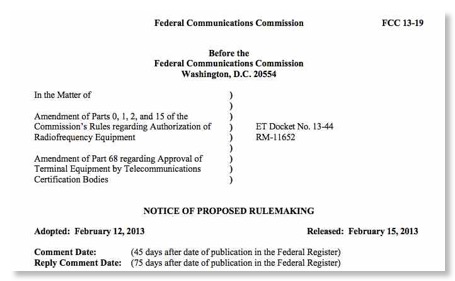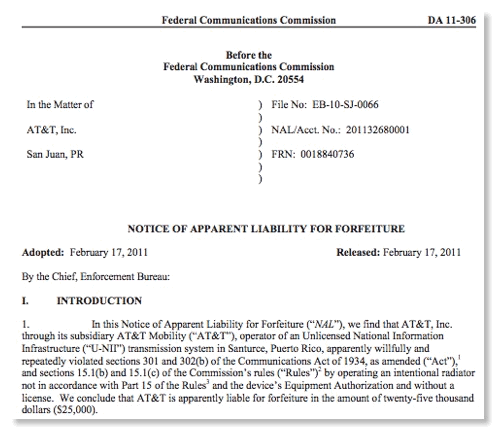Equipment Authorization NPRM: 1st Comments Deal with Enforcement
 Today the comments of Marcus Spectrum Solutions LLC in the Equipment Authorization Rulemaking, Docket 13-44, were posted on the Commission’s comment website, ECFS. These comments were the first filed and were filed early in an attempt to raise a key issue in this proceeding: the enforcement mechanism of rules must be credible in order to deter the introduction of noncompliant equipment into the US wireless market. The present equipment authorization rules are outdated and lack credibility with respect to enforcement because of changes in both the marker for wireless equipment and the technology used today.
Today the comments of Marcus Spectrum Solutions LLC in the Equipment Authorization Rulemaking, Docket 13-44, were posted on the Commission’s comment website, ECFS. These comments were the first filed and were filed early in an attempt to raise a key issue in this proceeding: the enforcement mechanism of rules must be credible in order to deter the introduction of noncompliant equipment into the US wireless market. The present equipment authorization rules are outdated and lack credibility with respect to enforcement because of changes in both the marker for wireless equipment and the technology used today.The real threat of continuing the current basic structures is twofold:
- Noncompliant equipment’s market share could increase and discourage compliance by legitimate manufacturers due to both price pressure and rapid copying of legitimate equipment.
- Noncompliant equipment could cause the very interference problems that the Commission’s Title III rules were designed to prevent!
The comments suggest changes in 4 areas:
- Criminalize the submission of fraudulent postmarket samples. FCC has never taken serious action against manufactures/imported who submit doctored samples.
- Codify key terms of KDB Publication No. 610077 and increase post-market sampling rate of TCBs. This obscure publication includes key requirements for TCBs to sample equipment on the market. Sampling should be increased above the present 5% and the requirements should be codified in the FCC Rules to make them clear to all
- Address TCBs’ basic conflict in post-market testing. Recognize that TCBs have conflicting incentives to identify their customers’ possible noncompliance
- Make post-market surveillance credible by including consistent retail sampling. In almost all cases FCC only tests samples provided by manufacturers/importers who have incentive to doctor noncompliant equipment on to test large numbers to find one that is atypical. FCC is urged to require TCBs to do some testing of models acquired from retail or wholesale sources at random. The widespread use of software to control transmitter parameters means that it is much easier to doctor a test sample now than it was when these rules were originally formulated.
It is hoped that other parties interested in this proceeding, especially groups representing licensees will consider these concepts and give their views on such topics in their own comments/reply comments.
FCC Enforcement in Action: The Mysterious AT&T San Juan Case
 The issue of FCC equipment marketing enforcement has been a recurring issue here. Mitchell Lazarus, writing recently in FHH CommLawBlog pointed out the strange case of a recent Notice of Apparent Liability dealing with alleged AT&T use of 5605 MHz in San Juan PR. The NAL states
The issue of FCC equipment marketing enforcement has been a recurring issue here. Mitchell Lazarus, writing recently in FHH CommLawBlog pointed out the strange case of a recent Notice of Apparent Liability dealing with alleged AT&T use of 5605 MHz in San Juan PR. The NAL statesAs part of its ongoing coordination efforts with the Federal Aviation Administration (“FAA”), the Enforcement Bureau received a complaint that radio emissions were causing interference on or adjacent to the frequency 5610 MHz to the FAA’s Terminal Doppler Weather Radar (“TDWR”) installation serving the San Juan International Airport. ... On December 7, 2010, agents from the Enforcement Bureau’s San Juan Office (“San Juan Office”) conducted an investigation on the roof of the Miramar Plaza Condominium Building in Santurce, Puerto Rico. The agents from the San Juan Office confirmed by direction-finding techniques that radio emissions on frequency 5605 MHz were emanating from the building’s roof, the location of one of AT&T’s U-NII transmitters, a Motorola Canopy. The Canopy model is certified for use as a Part 15 intentional radiator only in the 5735.0 - 5840.0 MHz band and is not certified as a U-NII intentional radiator.
In his blog post, Mr. Lazarus comments
In cases where a transmitter fails to match its certification, as here, the FCC usually cites the manufacturer. Going after AT&T makes sense only if the FCC thinks the transmitter was compliant when shipped, and that AT&T took it out of the box, re-tuned it to an unauthorized frequency, and turned off the DFS. That would indeed be a blatant offense. But the FCC does not accuse AT&T of doing this. The farthest it goes is to say AT&T “consciously” operated at the unauthorized frequency.

The original software defined radio (SDR) rules adopted in Docket 00-47 in September 2001 had the following requirement:
2.932(e) Manufacturers must take steps to ensure that only software that has been approved with a software defined radio can be loaded into such a radio. The software must not allow the user to operate the transmitter with frequencies, output power, modulation types or other parameters outside of those that were approved. Manufacturers may use authentication codes or any other means to meet these requirements, and must describe the methods in their application for equipment authorization.
In comments filed in Docket 03-108 this rule was challenged by several parties. The R&O states:
Motorola Canopy model #5700A number of parties support a requirement for devices to comply with the rules for software defined radios if the software and operating parameters can be easily changed post- manufacture and/or that pose a high risk of causing interference to licensed services such as public safety.
Intel states that those devices that use software defined radio as a manufacturing technique and are not intended to be modified in the field should not be required to be declared as software defined radios, and that the Commission should impose requirements on only those devices where the manufacturer intends to allow modifications in the field. Vanu, Inc., a manufacturer of software defined radios, believes that mandatory certification as software defined radios may be desirable when harmful interference may result from a foreseeable modification to the device’s software by a third party. It states that the Commission could adopt security requirements that are not limited to radios that meet the definition of software defined radios. The National Public Safety Telecommunications Council and the SDR Forum believe that the Commission’s concern should not be that a radio could be reprogrammed on an individual basis because the number of radios potentially affected that way would not be significant.

So there are several possible explanations of what happened in the San Juan case:
- an unintentional manufacturing error in software or hardware left the Canopy unit capable of operating at 5605 MHz. (Use of this frequency is only permitted if the unit has dynamic frequency selection capability to avoid radar systems. This Canopy unit does not have that capability.)
- Motorola violated its equipment authorization grant and intentionally shipped a unit capable of operating on 5605 MHz
- AT&T or a contractor modified the the software in the Canopy unit to change the frequency out of the authorized band.
So while I don’t have a lot of sympathy for AT&T in this case, it would appear that either Motorola is at fault in its sale of the Canopy unit, in which case its dealers would also be culpable or this case highlights an error in the logic used by the Commission in 2005 for watering down the former 2.932(e) requirement into the present much weaker 2.944 requirement.
It is ironic that when I spoke to the SDR Forum on a panel last year (just prior to the group changing its name to Wireless Innovation Forum) someone asked the panel if the FCC SDR security rules were too weak. I think they are and are the most likely root cause of this incident, but that is what the SDR Forum and others myopically asked for in Docket 03-108 and the FCC complied, ignoring concerns stated by Cingular/Bellsouth at the time.
Let’s hope FCC gives us a full explanation of what really happened in San Juan so we can avoid similar events in this and other bands.
While we are at it, it would also be useful for FCC and NTIA to publicly state why TDWR interference is a recurring problem given that NTIA was able to dictate the terms of the U-NII rules for the shared band. I suspect that DoD dominated the IRAC discussions of the issue and FAA naively assumed that DoD would watch out for all federal radars, not just military units, so did not realize until it was too late that TDWR was different than the military units in some key aspects.



![Validate my RSS feed [Valid RSS]](valid-rss-rogers.png)

